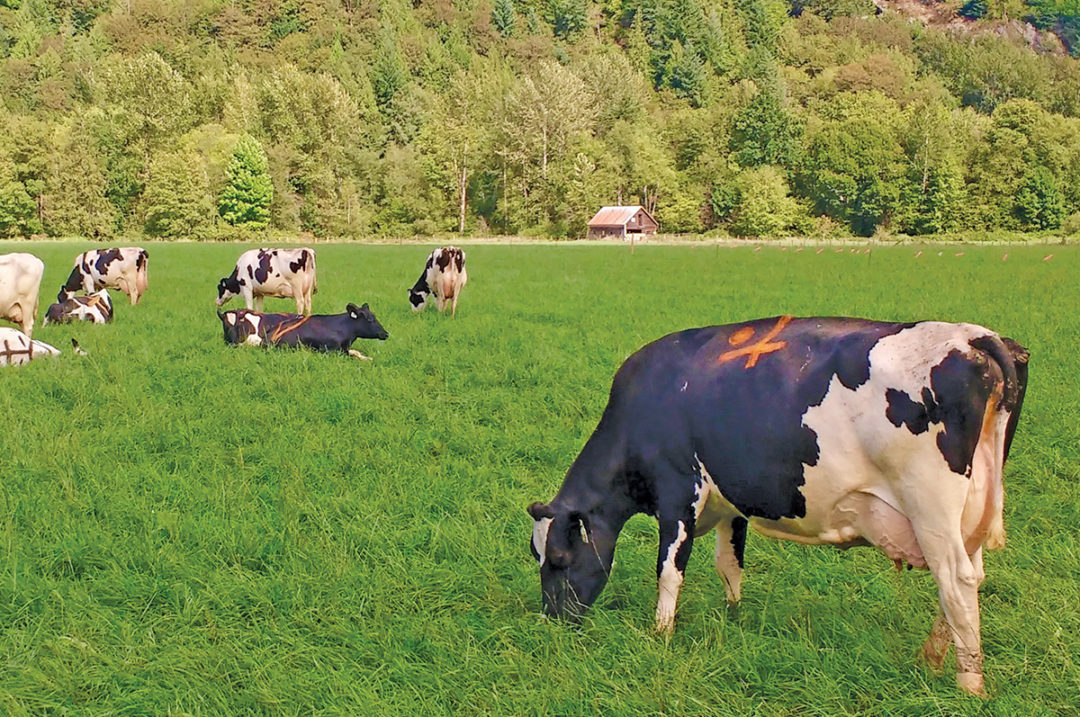Recent research from Europe and Canada has demonstrated cows have a strong preference to be on pasture, especially during summer nights.
If pasture is not available, cows continue to demonstrate a preference for outdoor access, preferring to spend approximately half their summer nights outside on bedded packs when offered. Additionally, research has indicated many members of the public value outdoor access for dairy cows, believing the cow’s ability to perform natural behaviours like grazing, in addition to access to more space, are valuable.
A recent national survey indicated approximately 30% of Canadian dairy farms provide lactating cows access to pasture, and roughly 60% of farms provide dry cows pasture access. Numbers accounting for the use of alternative outdoor areas other than pasture in Canada, such as deep-bedded packs and drylots, are lacking.
Given cows, the public and many producers value outdoor access, it is important to gain a better understanding of the perspectives of dairy farmers on this topic.
In a recent study, I interviewed 56 western Canadian dairy farmers to understand their views on outdoor access for dairy cattle. I asked participating farmers a series of questions to understand why they do or do not provide outdoor access on their farms and to gain an understanding of their views on the perception of other stakeholders relating to this topic. Here are some of the results I uncovered.
Reasons to provide outdoor access (or not)
Participating producers expressed contentment over seeing cows on pasture or outdoors. However, many felt providing outdoor access was not feasible on their farms. The reasons cited for providing outdoor access – or not – revolved around five main themes: climate, cow welfare, economics, infrastructure and management (Illustration 1).
 Illustration by Lucia Amendola.
Illustration by Lucia Amendola.Climate
Participating farmers indicated cold and wet climates are barriers to providing outdoor access, coupled with a short seasonal window where access is suitable. Others mentioned local climate conditions are conducive to outdoor access, especially referring to milder climates in parts of British Columbia and the drier prairies.
Cow welfare
Many participants expressed support for modern freestall barns, which they said provide the best environment for the cow, providing a more consistent daily routine for the animals. Some participants also expressed fears outdoor access could be harmful to cow health, including a perceived increase in incidence of transition cow diseases, udder health problems and loss of body condition.
Conversely, other participants cited the belief outdoor access provides cows with important health benefits. For these participants, moving cows off of concrete was given particular importance, as it was perceived to improve hoof health and reduce the risk of lameness. Some participants also expressed beliefs outdoor access for dry cows decreases the risk of transition diseases.
Increased exercise opportunities of outdoor access were generally seen as healthy and adding to longevity. As one participant shared, “That is why we have to be careful with the word ‘pasture’. We are not always sending cows outside to graze, but just having them outside so they can experience fresh air and be off the concrete is a huge benefit already.”
Economics
Concerns over decreased milk and butterfat production were cited as reasons not to pasture lactating cows. Participants also shared that high land prices have made growing crops on their land more profitable than using the land for pasture.
The investment in a barn was also considered a reason not to provide outdoor access. “We have winter facilities anyway. So keeping them both in the summer and winter in the barns wasn’t that big of a step really,” noted one participant.
However, farmers who pastured their lactating cows said they did not experience reduced milk or butterfat production, and some cited the premium milk price for organic milk as motivation to pasture lactating cows. Others mentioned outdoor access could result in savings in operation costs, including reduced expenses for bedding and feed.
Outdoor access was sometimes cited as more profitable than indoor housing, given the reductions in housing costs, and some argued using land not suitable for other purposes beyond pasturing animals was economically favourable.
Infrastructure
Based on the design of many farms, some farmers felt their own facility design formed a barrier to providing outdoor access. This could be due to reasons such as the presence of buildings that block outdoor access or a far distance between suitable pasture and milking facilities. One participant explained the challenges this can present, “I think if you do it, and you have always been doing it, then you plan for it when you make changes with your buildings. It’s hard to change once you have everything set up for having the cows inside.” This generally resonated with farmers who provide outdoor access, as they noted their experiences allowed for easy outdoor access due to an outdoor access-conducive farm layout.
Management
Improved working conditions that provide better control and improved ability to manage animals in the barn was another factor producers cited when considering outdoor access. Many perceived a growing management challenge when providing outdoor access for larger herds.
 When pasture access is not available, research shows dairy cattle continue to demonstrate a preference for outdoor access in other forms such as bedded packs (pictured), yet many barriers to implementation exist for farms. Photo provided by Anne-Marieke Smid.
When pasture access is not available, research shows dairy cattle continue to demonstrate a preference for outdoor access in other forms such as bedded packs (pictured), yet many barriers to implementation exist for farms. Photo provided by Anne-Marieke Smid.A lack of research and knowledge around the provision of outdoor access was also seen as a barrier to its implementation. Meanwhile, others argued outdoor access reduced their workload, requiring less time spent feeding and harvesting grass for silage, among other factors. For some producers, pasturing dry cows and heifers was considered easier than pasturing lactating cows. Furthermore, farmers implementing outdoor access did not perceive it as disruptive to cow routine.
Producer perspectives on the views of other stakeholders regarding outdoor access
Our study also investigated how farmers viewed the perception of other stakeholders (i.e., the dairy industry, dairy cows and the public) with regard to outdoor access.
The dairy industry
Outdoor access was not considered a major talking point within the Canadian dairy industry. Rather, how to improve cow welfare indoors was considered a more frequent topic of conversation. “I feel like the industry perspective is … it’s kind of a ‘been there, done that’,” concluded one participant.
Supply management was generally viewed as a barrier to offering pasture access for lactating cows, as it requires a consistent flow of production, something thought to be better realized by indoor housing. Concerns were raised by some participants that outdoor or pasture access would become mandatory, and many emphasized the importance of respecting individual farm choice regarding the provision of outdoor access.
The dairy cow
Mixed views arose regarding dairy cow preference for outdoor access. Certain producers noted it would be favourable to provide cows with a choice between indoor and outdoor environments. However, the consensus was that good cow welfare could be achieved using either system.
General public
Participants of the study held the perception that the public views cows outdoors, and in some cases on pasture specifically, in a positive light. Despite this perception, producer participants often regarded the public as uninformed, surmising that preference for outdoor access would dissipate were the public better educated on dairy farming.
Producers voiced concerns regarding the marketing of dairy products with images of dairy cows on pasture. Although considered effective, participants cited the possibility of unmet expectations, leading to public mistrust. It was mentioned that: “As an industry we have promoted pasture access as our image.… So we have done it to ourselves; we haven’t given consumers a true perspective, our perception of what we actually do.…When [the public] come on a farm … that is what they are expecting to see. And when they don’t see it, that’s when they start asking these questions.” Additionally, animal advocates were perceived to hold the ability to negatively influence public perspectives on dairy farming.
The producers surveyed generally held the belief that the willingness of the public to pay for products sourced from animals provided with pasture access was less than their voiced support for pasture access itself, with one farmer stating: “It would be nice if people would put their values where their mouth is.”
At the University of Calgary, we are currently investigating if the perspectives identified in this study with western Canadian dairy farmers also apply to the broader Canadian dairy farmer population. We hope the results of these studies will help guide the dairy industry in conversations around outdoor access for dairy cows and that it can inform the public on the complex issues affecting farmers’ decisions to provide outdoor access to their cows.
References omitted but are available upon request by sending an email to the editor.











